Different magmatic systems developed during the Eo-Oligocene on and around the Alpine Belt, favouring the accumulation of thick volcanogenic submarine sedimentary sequences in the coveal foreland and foredeep basins.
- periadriatic magmatism
- northern alpine foreland basin
- Northern Apennines
- Taveyanne sandstones
- Val d’Aveto–Petrignacola formation
- SE France
1. Introduction
2. The Source: Alpine Belt and Periadriatic Magmatism
2.1. The Al pine Belt
2.2. Plutonism
The most known expression of the Cenozoic magmatic activity in the Alps is represented by the large plutons aligned or near the PFS (Figure 1 and Figure 2). Their emplacement was, in the beginning, considered as the crustal expression of a deep geodynamic mechanism known as slab break-off [20], and magmas ascended along the PFS [21]. In 2015, [22] postulated that the magmatic event was triggered by the retreat of the European slab and the progressive shift of the subduction partial melting zone from SE (Venetian area) to the orogeny before the slab break-off, on the base of geochemical and geochronological data on dykes of the Southern Alps. Currently, the work of [23] (and ref. therein), based on the tomographic images showing the unbroken European slab below the Adriatic plate, indicates that slab steepening, and not slab break-off, triggered the magma generation.
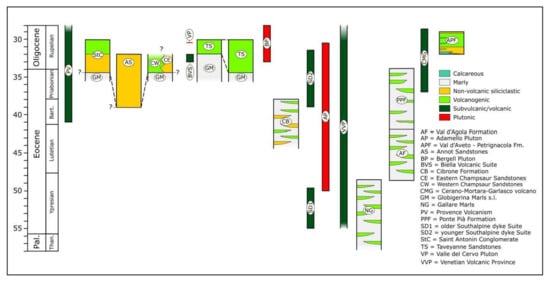
2.3. Volcanoes and Volcanogenic Sequences
3. The Sink: Alpine Peripheral Basins and Their Stratigraphy
3.1. The Northern Alpine Foreland Basin (NAFB)
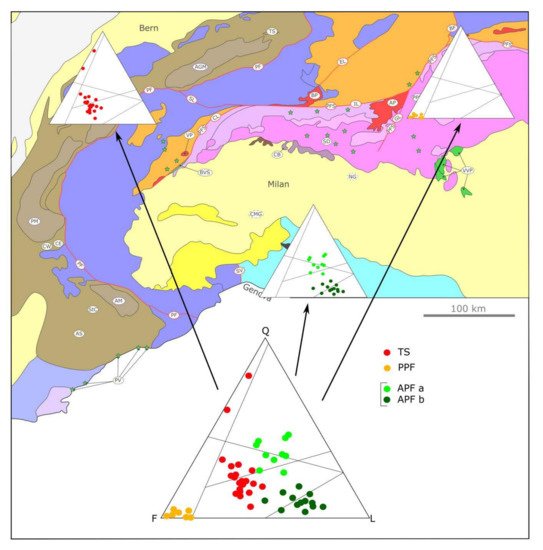
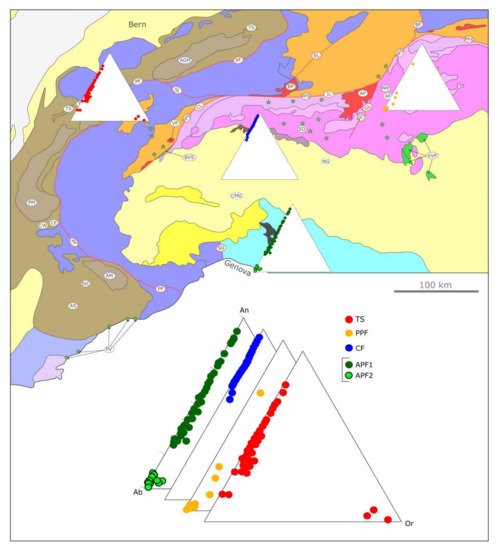
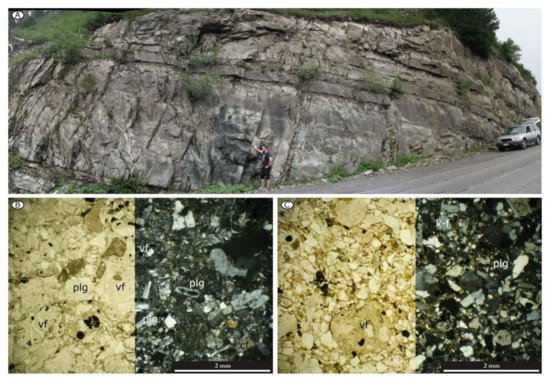
3.2. The Adriatic Foredeep

3.3. The Northern Apennine Foredeep
As in the Adriatic Foredeep, the Eocene sedimentary record of the Northern Apennine Foredeep basin was characterized by the accumulation of muddy, marly and calcareous sediments with rare sandy intercalations (e.g., Argille e Calcari di Canetolo, Flysch di Vico [46]). According to [55] (and ref. therein), in fact, most of the terrigenous supply coming from the Ligurian Alps and Corsica was trapped into the piggyback basins interposed between the Ligurian–Penninic orogenic wedge and the foredeep basin. In these basins, also rare volcaniclastic intercalations occur during the Middle Eocene (Montepiano Marls) and the Early Oligocene (Ranzano Formation) [54]. These volcaniclastic layers are constituted of fresh and euhedral single minerals of plagioclase, variable amounts of ferromagnesian minerals (biotite, amphibole and opaques), rare volcanic rock fragments and volcanic quartz [54].
In the foredeep basin, instead, the first massive clastic inputs began the accumulation during the Oligocene (ca. 32 Ma, Rupelian), and led to the progradation of the nonvolcanic turbidite system of the lower part of the APF [29][31][46]. The APF has a complex stratigraphy, and its products are not limited to siliciclastic deposits [46][56]. At the bottom, a thick sequence of calcareous turbidites interfingering with fine drapes of varicoloured claystones opens the sedimentary sequence. Above it, thick packages of sandstones and conglomerates are arranged in channel and overbank deposits [56]. These sediments are mainly composed of metamorphic (quartzites, ortogneiss, paragneiss, amphibolite micaschists and rare metagabbros), non-coeval magmatic (granite, pegmatite, dacite, slightly metamorphosed rhyolite and andesite) and minor sedimentary detritus (Figure 3) [31][46][56]. As indicated by [56], Sardinia–Corsica block, SE France (Provence area) and Ligurian Alps are the most suitable areas from where the detritus came during the Oligocene. According detrital U/Pb zircon ages, [9] indicate that the Alps were the only source of the APF detritus. At around 31.09 ± 0.30 Ma (U/Pb on zircons [9]) until 29.2 Ma (40Ar/39Ar age on a volcanic clast [57]), large volumes of volcanogenic detritus started to feed the turbidite system, overwhelming and/or mixing with the nonvolcanic supply [31][46]. Documented also by [47][56], for the first time, an almost 60 m-thick sequence of channelized pyroclastic density current deposits (from a metre to several metres thick) overlain by a debris avalanche deposit (Figure 3, Figure 4 and Figure 7).
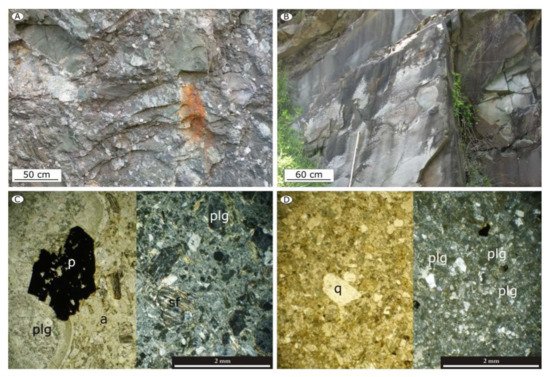
4. Reassessing the Source-to-Sink System
Most of the volcanic sources and their primary connections with depocenters have been, in fact, completely disarticulated or deleted by the post-Rupelian evolution of the belt. Close to the thick outcropping volcanogenic successions, almost no volcanic features have been recognized. On the contrary, where volcanogenic detritus is restricted to thin and scattered layers, volcanic features are represented by small volcanic bodies and effusive products accumulated on top of the Mesozoic sequences or the Hercynian basement. These differences, inherited from the different tectonic evolution between the Northern and the Southern Alps across the PFS, pushed Alpine geologists to identify in the large Periadriatic plutons the deep roots of ancient volcanic edifices unroofed during the Chattian, which would have been the only sources of volcanogenic detritus for the entire foreland basins around the Alps [58]. This hypothesis has consequently influenced the reconstruction of the pathways that supplied the volcanogenic detritus to the NAFB, the Adriatic and the Northern Apennine foredeeps (e.g., [6][9][59]).
4.1. The Adriatic Foredeep
Although efficient to unravel the Alpine chain exhumation history, this oversimplification left along its path many clues fundamental in the reconstruction of volcanogenic aprons and their feeding systems. Combining stratigraphy with geochemical, petrographic and geochronological data, it is recognized that the first volcanogenic aprons and volcanic manifestations occurred in the Adriatic Foredeep. In the eastern part of the basin, volcanogenic aprons (Ponte Pià and Val d’Agola formations) were directly fed by the submarine eruptions of the VVP and eruptive centres related to the older suites of the Adamello [2][45] (Figure 8). To the west, the volcanogenic detritus of the Cibrone Formation was accumulated in the central part of the Adriatic Foredeep (accounting the biostratigraphic age of [35]). The abrupt incoming of volcanogenic detritus in the basin represents, for the Cibrone Formation, a proof that volcanism and sedimentation were contemporaneous [77]. Therefore, these volcanogenic layers could be considered as crystal‐rich tuffs, according to [66], and consequently interpreted as the product of pyroclastic density currents accumulated underwater [78] or their rework [79]. Although source is still uncertain, the occurrence of Cr-bearing spinels in the volcanogenic sediments, typical of basaltic to andesitic magmas from harzburgites of a Supra–Subduction Zone [65], might suggest that the volcanogenic detritus was originated by small eruptive centres on top of the subintrusive bodies described by [42] in the Southern Alps. These hypothetical eruptive centres were subsequently eroded, as such kind of volcanic morphologies are generally highly prone to erosion [80,81]). In addition, all the Cretaceous to Paleocene sequences actually interposed between the potential source area and the Cibrone depocenter have been structured, together with the same Cibrone Formation, only starting from 34 Ma [13]. This would imply that the biostratigraphy ages of [35] correspond to the depositional age of the Cibrone Formation and give a temporal constraint to the volcanic source, which therefore was not the Bergell magmatic system, in disagreement with [68] (Figure 8). On the other hand, if the ages provided by [68] are the correct ones, the tectonic event involving the Cretaceous to Paleogene pile must be postdated, but provenance from the Bergell magmatic system remains difficult to explain according to the paleocurrent directions [64].
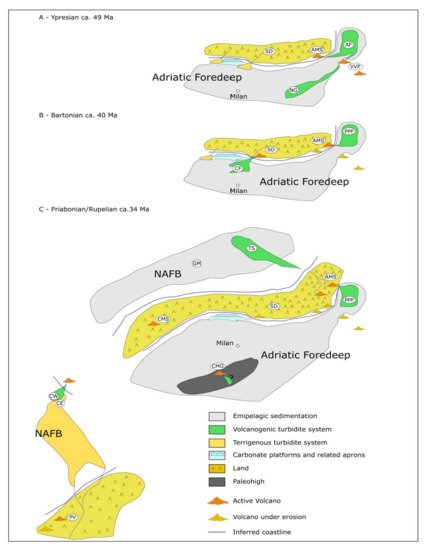
4.2. NAFB and the Source-to-Sink System
4.3. The Northern Apennine Foredeep
The recognition of the magmatic system sourcing the volcanogenic sequences of the APF is a fascinating problem that attracted many authors in the past decades [9][31][57][56]. The counterclockwise rotation of the Apennine belt consequently to the opening of the Tyrrhenian sea [62] further complicates this recognition. In addition, the different geodynamic reconstructions provided through the years further complicate the efforts in the repositioning of the sedimentary units where they were accumulated ([63] and ref. therein). Nevertheless, some constraints could be found matching the large amount of data available in the literature, indicating the SE France volcanism as the best place from where volcaniclastic detritus came from (Figure 9).5. Concluding Remarks
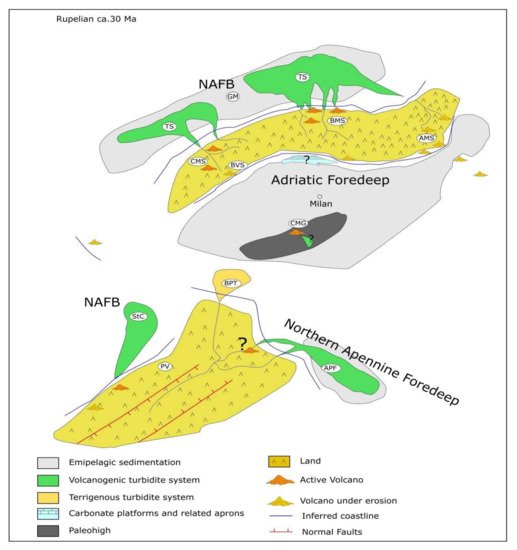
References
- Fantoni, R.; Bersezio, R.; Forcella, F.; Gorla, L.; Mosconi, A.; Picotti, V. New dating of the Tertiary magmatic products of the central Southern Alps, bearings on the interpretation of the Alpine tectonic history. In Proceedings of the 3rd Workshop on Alpine Geological Studies, Biella-Oropa, Italy, 1–29 October 1997.
- Martin, S.; Macera, P. Tertiary volcanism in the Italian Alps (Giudicarie fault zone, NE Italy): Insight for double alpine magmatic arc. Ital. J. Geosci. 2014, 133, 63–84.
- Kapferer, N.; Mercolli, I.; Berger, A.; Ovtcharova, M.; Fügenschuh, B. Dating emplacement and evolution of the orogenic magmatism in the internal Western Alps: 2. The Biella Volcanic Suite. Swiss J. Geosci. 2012, 105, 67–84.
- D’Adda, P.; Zanchi, A.; Bergomi, M.; Berra, F.; Malusà, M.G.; Tunesi, A.; Zanchetta, S. Polyphase thrusting and dyke emplacement in the central Southern Alps (Northern Italy). Int. J. Earth Sci. 2011, 100, 1095–1113.
- Stanley, D.J. The Saint-Antonin Conglomerate in the Maritime Alps: A Model for Coarse Sedimentation on a Submarine Slope. Smithson. Contrib. Mar. Sci. 1980, 5, 28.
- Ruffini, R.; Polino, R.; Callegari, E.; Hunziker, J.C.; Pfeifer, H.R. Volcanic clastic-rich turbidites of the Taveyanne sandstones from the Thônes syncline (Savoie, France): Records for a Tertiary postcollisional volcanism. Schweiz. Mineral. Petrogr. Mitt. 1997, 77, 161–174.
- Boyet, M.; La Pierre, H.; Tardy, M.; Bosch, D.; Maury, R. Nature des sources des composants andésitiques des Grès du Champsaur et des Grès de Tayevannaz. Implications dans l’évolution des Alpes occidentales au Palèogéne. Bull. Soc. Géol. Fr. 2001, 172, 487–501.
- Di Capua, A.; Groppelli, G. Application of actualistic models to unravel primary volcanic control on sedimentation (Taveyanne Sandstones, Oligocene Northalpine Foreland Basin). Sediment. Geol. 2016, 336, 147–160.
- Anfinson, O.A.; Malusà, M.G.; Ottria, G.; Davof, L.N.; Stockli, D.F. Tracking coarse-grained gravity flows by LASS-ICP-MS depth-profiling of detrital zircon (Aveto Formation, Adriatic foredeep, Italy). Mar. Pet. Geol. 2016, 1163–1176.
- Ogniben, L.; Parotto, M.; Praturlon, A. Structural Model of Italy—Maps and explanatory model. Quad. Ric. Sci. 1975, 90, 502.
- Lustrino, M.; Fedele, L.; Agostini, S.; Di Vincenzo, G.; Morra, V. Eocene-Miocene igneous activity in Provence (SE France): 40Ar/39Ar data, geochemical-petrological constraints and geodynamic implications. Lithos 2017, 288–289, 72–90.
- Lu, G.; Fellin, M.G.; Winkler, W.; Rahn, M.; Guillong, M.; von Quadt, A.; Willet, S.D. Revealing exhumation of the central Alps during the Early Oligocene by detrital zircon U–Pb age and fission‑track double dating in the Taveyannaz Formation. Int. J. Earth Sci. 2020, 109, 2425–2446.
- Zanchetta, S.; Malusà, M.G.; Zanchi, A. Precollisional development and Cenozoic evolution of the Southalpine retrobelt (European Alps). Lithosphere 2015, 7, 662–681.
- Lanza, R. Palaeomagnetic data on the andesitic cover of the Sesia-Lanzo Zone. West. Alps Geol. Rundsch. 1978, 68, 83–92.
- Berger, A.; Mercolli, I.; Kapferer, N.; Fügenschuh, B. Single and double exhumation of fault blocks in the internal Sesia-Lanzo Zone and the Ivrea-Verbano Zone (Biella, Italy). Int. J. Earth Sci. 2012, 101, 1877–1894.
- Price, J.B.; Wernicke, B.P.; Cosca, M.A.; Farley, K.A. Thermochronometry Across the Austroalpine-Pennine Boundary, Central Alps, Switzerland: Orogen-Perpendicular Normal Fault Slip on a Major “Overthrust” and Its Implications for Orogenesis. Tectonics 2018, 37, 724–757.
- Rubatto, D.; Hermann, J.; Berger, A.; Engi, M. Protracted fluid-induced melting during Barrovian metamorphism in the Central Alps. Contrib. Mineral. Petrol. 2009, 158, 703–722.
- Ciancaleoni, L.; Marquer, D. Syn-extension leucogranite deformation during convergence in the Eastern Central Alps: Example of the Novate intrusion. Terra Nova 2006, 18, 170–180.
- Garzanti, E.; Malusà, M.G. The Oligocene Alps: Domal unroofing and drainage development during early orogenic growth. EPSL 2008, 268, 487–500.
- Von Blackenburg, F.; Davies, J.H. Slab breakoff: A model for syncollisional magmatism and tectonics in the Alps. Tectonics 1995, 14, 120–131.
- Rosenberg, C.L. Shear zones and magma ascent: A model based on a review of the Tertiary magmatism in the Alps. Tectonics 2004, 23, 1–25.
- Bergomi, M.A.; Zanchetta, S.; Tunesi, A. The Tertiary dike magmatism in the Southern Alps: Geochronological data and geodynamic significance. Int. J. Earth Sci. 2015, 104, 449–473.
- Ji, W.-Q.; Malusà, M.G.; Tiepolo, M.; Langone, A.; Zhao, L.; Wu, F.-Y. Synchronous Periadriatic magmatism in the Western and Central Alps in the absence of slab breakoff. Terra Nova 2019, 31, 120–128.
- Tiepolo, M.; Tribuzio, R.; Ji, W.Q.; Wu, F.Y.; Lustrino, M. Alpine Tethys closure as revealed by amphibole-rich mafic and ultramafic rocks from the Adamello and the Bergell intrusions (Central Alps). J. Geol. Soc. 2014, 171, 793–799.
- Waibel, A.F. Sedimentology, Petrographic Variability, and Very-Low-Grade Metamorphism of the Champsaur Sandstones (Paleogene, Hautes-Alpes, France): Evolution of Volcaniclastic Foreland Turbidites in the External Western Alps. Ph.D. Thesis, University of Geneva, Geneva, Switzerland, 1989.
- Ruffini, R.; Cosca, M.A.; d’Atri, A.; Hunziker, J.C.; Polino, R. The volcanic supply of the Tertiary turbidites (Savoie, France): A riddle for Tertiary Alpine volcanism. Atti Del Convegno Rapp. Alpi Appennini 1994, 14, 359–376.
- Sciunnach, D.; Borsato, A. Plagioclase-arenites in the Molveno Lake area (Trento): Record of an Eocene volcanic arc. Acta Geol. 1994, 69, 81–92.
- Montenat, C.; Leyrit, H.; Gillot, P.-Y.; Janin, M.-C.; Barrier, P. Extension du volcanisme oligocène dans l’arc de Castellane (chaînes subalpines de Haute-Provence). Géol. Fr. 1999, 1, 43–48.
- Catanzariti, R.; Cerrina Feroni, A.; Ottria, G.; Levi, N. The Contribution of Calcareous Nannofossil Biostratigraphy in Solving Geological Problems: The Example of the Oligocene–Miocene Foredeep of the Northern Apennines (Italy). In Geologic Problem Solving with Microfossils: A Volume in Honor of Garry D. Jones 93; Demchuck, T.D., Gary, A.C., Eds.; SEPM Special Publication: Broken Arrow, OK, USA, 2009; pp. 309–321.
- Premoli Silva, I.; Tremolada, F.; Sciunnach, D.; Scardia, G. Aggiornamenti biocronologici e nuove interpretazioni ambientali sul Paleocene-Eocene della Brianza (Lombardia). Rend. Ist. Lomb. 2009. Available online: https://www.earth-prints.org/handle/2122/5386 (accessed on 3 January 2021).
- Mattioli, M.; Lustrino, M.; Ronca, S.; Bianchini, G. Alpine subduction imprint in Apennine volcaniclastic rocks. Geochemical–petrographic constraints and geodynamic implications from Early Oligocene Aveto-Petrignacola Formation (N Italy). Lithos 2012, 134–135, 201–220.
- Lu, G.; Winkler, W.; Rahn, M.; von Quadt, A.; Willett, S.D. Evaluating igneous sources of the Taveyannaz Formation in the Central Alps by detrital zircon U–Pb age dating and geochemistry. Swiss J. Geosci. 2018, 111, 399–416.
- Beccaluva, L.; Bigioggero, B.; Chiesa, S.; Colombo, A.; Fanti, G.; Gatto, G.O.; Gregnanin, A.; Montrasio, A.; Piccirillo, E.M.; Tunesi, A. Post collisional orogenic dyke magmatism in the Alps. Mem. Soc. Geol. Ital. 1983, 26, 341–359.
- Alagna, K.E.; Peccerillo, A.; Martin, S.; Donati, C. Tertiary to Present Evolution of Orogenic Magmatism in Italy. J. Virtual Explor. 2010, 36, 1–63.
- Kapferer, N.; Mercolli, I.; Berger, A. The composition and evolution of an Oligocene regolith on top of the Sesia–Lanzo Zone (Western Alps). Int. J. Earth Sci. 2011, 100, 1115–1127.
- Callegari, E.; Cigolini, C.; Medeot, O.; D’Antonio, M. Petrogenesis of calc-alkaline and shoshonitic post-collisional Oligocene volcanics of the Cover Series of the Sesia Zone, Western Italian Alps. Geodin. Acta 2004, 17, 1–29.
- Bersezio, R.; Bini, A.; Ferliga, C.; Gelati, R. Note Illustrative della Carta Geologica d’Italia alla scala 1:50000, Foglio Bergamo. ISPRA 2012. Available online: https://www.isprambiente.gov.it/Media/carg/98_BERGAMO/Foglio.html (accessed on 3 January 2021).
- Sinclair, H.D. Turbidite sedimentation during Alpine thrusting: The Taveyannaz sandstones of eastern Switzerland. Sedimentology 1992, 39, 837–856.
- Joseph, P.; Lomas, S.A. Deep-Water Sedimentation in the Alpine Foreland Basin of SE France: New Perspectives on the Grès d’Annot and Related Systems—An Introduction. In Geological Society; Special Publications: London, UK, 2004; p. 221.
- Salles, L.; Ford, M.; Joseph, P. Characteristics of axially-sourced turbidite sedimentation on an active wedge-top basin (Annot Sandstone, SE France). Mar. Pet. Geol. 2014, 56, 305–323.
- Vinnels, J.S.; Butler, R.W.H.; McCaffrey, W.D.; Lickorish, W.E. Sediment Distribution and Architecture Around A Bathymetrically Complex Basin: An Example from The Eastern Champsaur Basin, SE France. J. Sediment. Res. 2010, 80, 216–235.
- Debelmas, J.; Durozoy, G.; Kerckhove, C.; Monjuvent, G.; Mouterde, R.; Pècher, A. Carte Géologique de la France (1:50,000), Feuille Orcières (846); Bureau de Recherches Gèologiques et Minières: Orleans, France, 1980.
- Lateltin, O. Les Dépôts Turbiditiques Oligocènes D’avant-Pays Entre Annecy (Haute-Savoie) et le Sanetsch (Suisse). Ph.D. Thesis, Fribourg University, Fribourg, Switzerland, 1988; p. 127.
- Féraud, G.; Ruffet, G.; Stéphan, J.F.; Lapierre, H.; Delgado, E.; Popoff, M. Nouvelles données géochronologiques sur le volcanisme paléogène des Alpes occidentales: Existence d’un événement magmatique bref généralisé. Séanc. Spéc. Soc. Géol. Fr. 1996, 38, 25–26.
- Lu, G.; Di Capua, A.; Winkler, W.; Rahn, M.; Guillong, M.; von Quadt, A.; Willet, S.D. Restoring the source‑to‑sink relationships in the Paleogene foreland basins in the Central and Southern Alps (Switzerland, Italy, France): A detrital zircon study approach. Int. J. Earth Sci. 2019, 108, 1817–1834.
- Elter, P.; Catanzariti, R.; Ghiselli, F.; Marroni, M.; Molli, G.; Ottria, G.; Pandolfi, L. L’Unità Aveto (Appennino Settentrionale): Caratteristiche litostratigrafiche, biografia, petrografia, delle areniti ed assetto strutturale. Boll. Della Soc. Geol. Ital. 1999, 118, 41–63.
- Di Capua, A.; Groppelli, G. Emplacement of pyroclastic density currents (PDCs) in a deep-sea environment: The Val d’Aveto Formation case (Northern Apennines, Italy). J. Volcanol. Geotherm. Res. 2016, 328, 1–8.
- Coletti, G.; Vezzoli, G.; Di Capua, A.; Basso, D. Reconstruction of a lost carbonate factory based on its biogenic detritus (Ternate-Travedona Formation and Gonfolite Lombarda Group—Northern Italy). Riv. Ital. Paleontol. Stratigr. 2016, 122, 1–22.
- Barbieri, G.; Grandesso, P. Note illustrative della Carta Geologica d’Italia alla scala 1:50000. Foglio Asiago. ISPRA 2007. Available online: https://www.isprambiente.gov.it/Media/carg/veneto.html (accessed on 3 January 2021).
- Bini, A.; Sciunnach, D.; Bersezio, R.; Scardia, G.; Tomasi, F. Note illustrative della Carta Geologica d’Italia alla scala 1:50000. Foglio Seregno. ISPRA 2015. Available online: https://www.isprambiente.gov.it/Media/carg/96_SEREGNO/Foglio.html (accessed on 3 January 2021).
- Castellarin, A.; Picotti, V.; Cantelli, L.; Claps, M.; Trombetta, L.; Selli, L.; Carton, A.; Borsato, A.; Daminato, F.; Nardin, M.; et al. Carta Geologica D’ltalia, 1:50 000, F. 080 Riva Del Garda, Con Note Illustrative; APAT: Roma, Italy, 2005; p. 145.
- Sciunnach, D. Geochemistry of Detrital Chromian Spinel as a Marker for Cenozoic Multistage Tectonic Evolution of the Alps. Rend. Online Soc. Geol. Ital. 2014, 32, 15–23.
- Gavazzi, A.; Miletta, S.; Sciunnach, D.; Tremolada, F. Eocene plagioclase-arenites from the Southern Alps: Record of a “meso-Alpine” volcanic arc. Ann. Uniservitatis Sci. Bp. Sect. Geol. 2003, 35, 102–103.
- Di Giulio, A.; Dunkl, I.; Falletti, P.; Sciunnach, D. Plagioclas-arenites from the Northern Apennines and Southern Alps: Record of a Paleogene island arc related to Alpine subduction. In Proceedings of the 7th Alpine Workshop, Opatija, Croatia, 29 September–1 October 2005.
- Cibin, U.; Di Giulio, A.; Martelli, L. Oligocene-Early Miocene Tectonic Evolution of the Northern Apennines (Northwestern Italy) Traced Through Provenance of Piggy-Back Basin Fill Successions. In Tracing Tectonic DeJormation Using the Sedimentary Record; Mccann, T., Saintot, A., Eds.; Geological Society; Special Publications: London, UK, 2003; Volume 208, pp. 269–287.
- Di Capua, A.; Vezzoli, G.; Groppelli, G. Climatic, tectonic and volcanic controls of sediment supply to an Oligocene Foredeep basin: The Val d’Aveto Formation (Northern Italian Apennines). Sediment. Geol. 2016, 332, 68–84.
- Mattioli, M.; Di Battistini, G.; Zanzucchi, G. Geochemical features of the Tertiary buried Mortara volcanic body (Northern Apennines, Italy). Boll. Soc. Geol. Ital. 2002, 1, 239–249.
- Malusà, M.G.; Villa, I.M.; Vezzoli, G.; Garzanti, E. Detrital geochronology of unroofing magmatic complexes and the slow erosion of Oligocene volcanoes in the Alps. EPSL 2011.
- Jacobs, J.; Paoli, G.; Rocchi, S.; Ksienzyk, A.K.; Sirevaag, H.; Elburg, M.A. Alps to Apennines zircon roller coaster along the Adria microplate margin. Sci. Rep. 2018, 8, 2704.
- Bodelle, J. Les Formations Nummulitiques de I’Arc de Castellane. Ph.D. Thesis, Universite de Nice, Nice, France, 1971; p. 582.
- Di Capua, A.; Groppelli, G. The riddle of volcaniclastic sedimentation in ancient deep-water basins: A discussion. Sediment. Geol. 2018, 378, 52–60.
- Gattacceca, J.; Deino, A.; Rizzo, R.; Jones, D.S.; Henry, B.; Beaudoin, B.; Vadeboin, F. Miocene rotation of Sardinia: New Paleomagnetic and geochronological constraints and geodynamic implications. Earth Planet. Sci. Lett. 2007, 258, 359–377.
- Molli, G. Northern Apennine–Corsica Orogenic System: An Updated Overview. In Tectonic Aspects of the Alpine-Dinaride-Carpathian System; Geological Society; Siegesmund, S., Fügenschuh, B., Froitzheim, N., Eds.; Special Publications: London, UK, 2008; Volume 298, pp. 413–442.
- Rossi, M.; Mosca, P.; Polino, R.; Rogledi, S.; Biffi, U. New outcrop and subsurface data in the Tertiary Piedmont Basin (NW-Italy): Unconformity-bounded stratigraphic units and their relationships with basin-modification phases. Riv. Ital. Paleontol. Stratigr. 2009, 115, 305–335.
- Turrini, C.; Toscani, G.; Lacombe, O.; Roure, F. Influence of structural inheritance on foreland-foredeep system evolution: An example from the Po valley region (northern Italy). Mar. Pet. Geol. 2016, 77, 376–398.

